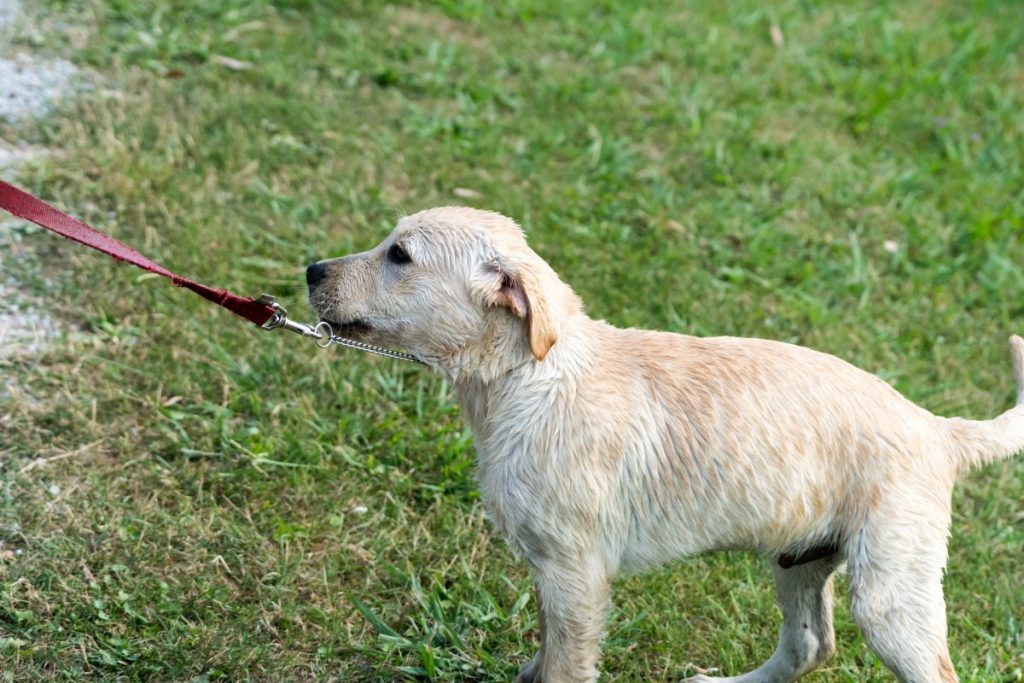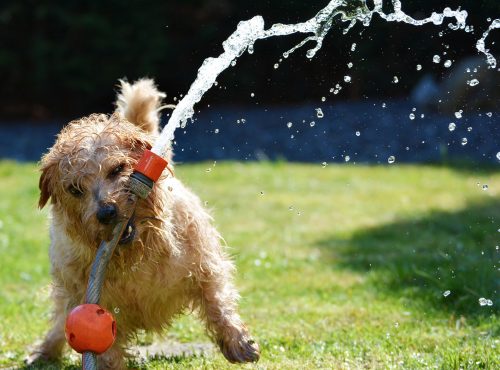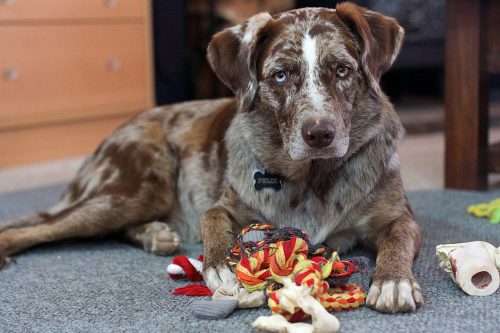Sit. Shake. Down. Stay. Part of the fun of having a dog is teaching him tricks and guiding his behavior, allowing a richer, safer life for you and your pup. However, not all dogs are the same. While the range of personalities and abilities is part of what make dogs so great, it also means that some dogs may be harder to train than others.
Trying to train a stubborn pup can be frustrating, but it’s not impossible. Here is some information and tips for training your stubborn dog.
When is a Dog Considered “Stubborn”?
Stubbornness tends to be an umbrella term referring to dogs that may be harder to train. Some dogs are truly headstrong, but many will have trouble obeying if they don’t see what’s in it for them.
Other dogs actually have a high sense of independence and were bred to perform tasks away from humans, meaning they require little praise or treats. Some dog breeds may seem stubborn, but are actually highly intelligent. That intelligence manifests as them being bored with and unwilling to perform simple tasks.
Some dog breeds are more inclined to this stubbornness than others. The most stubborn dog breeds include:
- Beagles are highly independent and adventurous when left to their own devices, making them more likely to get into trouble when you’re not at home.
- English Bulldogs are intelligent and will ignore owners who don’t show them the respect they deserve.
- Dachshunds are independent and possess a bit of an inferiority complex. They will take on bigger dogs just because they think they can.
- Jack Russell Terriers are tough, energetic, and smart. They have no problem taking advantage of owners who may be less confident or indecisive.
- Rottweilers are amazing family dogs, but they do need a bit of a firm hand in training. They are a strong breed and may readily take command of their pack (in this case, you and your family).
- Mastiffs are independent and require plenty of exercise and activity to make sure they don’t expend energy in their own mischievous ways.
- Chinese Shar-Peis can be devoted family dogs, but they tend to be highly independent. Getting through to them often comes down to earning their loyalty.
- Afghan Hounds are one of the oldest breeds, and while they are beautiful and elegant, they can be aloof when dealing with human families.
- Scottish Terriers are independent and fine with having a small inner circle of close friends. They tend to be one-human breeds, but that one human needs to make sure to practice good leadership to ensure good obedience.
- Weimaraners are smart and witty and require a master who will match their intelligence and energy.
Some forms of stubbornness come down to what dogs were bred for. For example, terriers were bred for hunting and killing rabbits, foxes, and other small game. They were not bred to retrieve, so teaching them to play fetch might be difficult unless your terrier has a good reason for returning a ball to you.
Tips for Training a Stubborn Dog
Most often, a dog that doesn’t listen or has trouble following orders just doesn’t understand human manners. Most natural dog behaviors don’t coincide with human standards for good behavior. It just comes down to time and effort, but that doesn’t mean you have to completely change your training strategies. Sometimes, it just takes some slight, simple tweaks.
Take It Slow
Consider slowing down your training. Focus on a command that your dog enjoys or is familiar with and reward even the most minor of successes. This is all to help your dog understand that training is a good, fun, positive thing that comes with plenty of treats, praise, and belly rubs.
From there, take small steps to change certain variables. For instance, once your dog has mastered a command, add a distraction—turn on the television, put on some music, have a friend in the same room. Just remember to take it slow and feel free to take a step back if your dog continues to have trouble.
Don’t Repeat a Command Too Much
You should only have to state a command once. Repeating the same command several times until your dog does eventually sit or lie down eventually becomes a learned behavior that becomes hard to break.
If your dog ignores your command, it’s usually because the dog is distracted or hasn’t been taught properly. If he doesn’t respond at first, take your dog to a quiet area and ask again. If your dog is still ignoring you, start from the beginning and re-teach him until he fully commits to it.
Control Your Dog’s Environment
Your dog’s “stubbornness” is most often a result of environmental distractions—people, other dogs, wayward squirrels. When the environment is filled with much more interesting, desirable things, it’s hard for your dog to focus on sitting.
During your lessons, take the proper precautions to create an environment to help your dog focus. Treat it like teaching in a classroom. You wouldn’t want to learn or study in a loud, busy area. Conduct the lessons in your kitchen, living room, or other distraction-free area in your home.
Put away toys, food, and other items that your dog may be tempted to play with, eat, or chew on. If you must train your pup outside, keep your dog on a leash or stay in a properly fenced-in area. Even the most well-behaved dogs can be tempted by a stray cat, squirrel, or car backfiring. The more comfortable you can make your dog, the easier he can learn.
Be Consistent
This is easier when you’re working with your dog on your own. However, when friends or family members visit, they may be asking your dog for the same behaviors in different ways or rewarding behaviors differently. This may just confuse your dog, so he may not react at all, making him seem stubborn.
Make sure that everyone who spends any extended time with your dog uses consistent cues and commands when training your pup. Keep the rewards consistent in amount and when they are distributed. This makes it more likely that your dog will do what you want him to.
Use Positive Reinforcement
As an owner, it’s easy for you to get frustrated when your dog seems to not listen or behave the way you want. Many owners who get frustrated resort to physical or verbal abuse. Aside from just being not right, any form of abuse will only prove to backfire on your training efforts.
Anecdotal evidence and research suggest that punishment is more likely to force your dog to shut down or becoming unwilling to learn, while positive reinforcement will encourage dogs to keep going even if they’re having a tough time.
Studies also show that verbal and physical punishments increase your dog’s anxiety and undermine his trust in you as owner and friend. In the long run, continued physical punishment will make your dog more aggressive.
Always, always, always train with positive reward-based training. This focuses on giving your pup things he desires, like food, playtime, and belly rubs, when he does something right. If your dog does any sort of unwanted behavior, redirect him to more desirable behaviors and reward him for those behaviors.
Use the Right Rewards
The more rewarding the training is, the more likely your dog will want to take part in lessons. If the rewards aren’t good enough or infrequent, your dog will lose interest and likely suffer in the long run. Increasing the frequency of treats and their value can lead to some dramatic training responses.
While treats tend to be the main reward, different dogs value different things. Figure out what your dog loves the most, whether it’s pets or extra play time with a favorite toy. If you do go with treats, remember that not all treats are created equal. If you’ll be giving a lot of treats during your training sessions, choose a healthier option, like veggies or fruits.
Treats may also work against you. Your dog may become so fixated on food that he will stop focusing on the training or on you. Your best bet is to use treats to initiate behaviors or reinforce behaviors later on. Once your pup learns a new behavior, replace those treats with play, praise, toys, and all his other favorites.
Understand that you yourself are a treat. You giving your dog positive attention and responding happily when he does something great is just as great as a delicious piece of steak.
Make Training a Habit
Schedule some time every day to train your dog. It should be part of your daily routine. Instead of a single session, hold several short training sessions during the day.
At the same time, make sure that the training sessions do not go extra long. The time you spend on training should end with positive results. As soon as you attain some form of success (even if it’s something small, like a moment of focus or noticeable attempts to perform), reward your pup, and end the lesson. If you keep training your dog, he may get bored. Over time, your dog will become disinterested in learning any new behaviors.
Don’t Be Afraid to Seek Professional Help
If you really have trouble getting through to a stubborn pup, don’t be afraid to get help from a professional dog trainer or veterinary behaviorist. This is especially true if your dog is showing signs of aggression, anxiety, or fear. This can be potentially dangerous for you, your dog, and others around you.
Talk with your vet to find a qualified trainer who uses positive reward-based methods. There’s no shame in asking for help or guidance. Every dog is so different, so there isn’t necessarily a one-size-fits-all solution. A trainer can teach you proper methods for improving your specific dog’s behavior and can give you the confidence you need train your dog at home.
Just remember that while some dogs can be difficult to train, much of the blame comes down to you and how you handle your pup’s behaviors. Love, patience, and consistency are the keys to fostering all aspects of your relationship with your dog.







